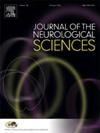Effect of renal function on dual antiplatelet therapy using cilostazol for stroke prevention: a CSPS.com trial post hoc analysis
IF 3.2
3区 医学
Q1 CLINICAL NEUROLOGY
引用次数: 0
Abstract
Background
The effect of renal function on long-term dual antiplatelet therapy using cilostazol for secondary stroke prevention is unknown. We investigated the effect of estimated glomerular filtration rate (eGFR) on the efficacy and safety of long-term dual antiplatelet therapy involving cilostazol.
Methods
We performed a post hoc analysis of a multicenter, open-label, randomized controlled trial of patients with high-risk non-cardioembolic ischemic stroke who were randomly assigned to take aspirin or clopidogrel alone, or a combination of cilostazol with aspirin or clopidogrel and followed for 0.5–3.5 years. Patients were divided into three groups according to their baseline eGFR [normal or increased eGFR (≥90); mildly decreased eGFR (60–89); moderately decreased eGFR (<60 mL/min/1.73m2)].
Results
A total of 1749 patients with complete eGFR data were included. The recurrence of ischemic stroke was less common with dual therapy than with monotherapy in patients with mildly decreased eGFR (adjusted HR, 0.35; 95 % CI, 0.19–0.66), but there was no difference between dual therapy and monotherapy in patients with moderately decreased eGFR (0.78; 0.34–1.82) or in those with normal or increased eGFR (0.48; 0.14–1.64).
Conclusions
Long-term dual antiplatelet therapy with cilostazol was more efficacious in decreasing recurrent ischemic stroke than monotherapy for patients with mildly decreased eGFR, but not for those with moderately decreased eGFR or those with normal or increased eGFR.
Trial Registration Information: ClinicalTrials.gov NCT01995370
肾功能对西洛他唑双重抗血小板治疗预防中风的影响:一项CSPS.com试验事后分析
背景:肾功能对长期使用西洛他唑双重抗血小板治疗预防继发性脑卒中的影响尚不清楚。我们研究了估计的肾小球滤过率(eGFR)对西洛他唑长期双重抗血小板治疗的疗效和安全性的影响。方法:我们对一项多中心、开放标签、随机对照的高风险非心源性缺血性卒中患者进行了事后分析,这些患者被随机分配单独服用阿司匹林或氯吡格雷,或西洛他唑与阿司匹林或氯吡格雷联合服用,随访0.5-3.5年。根据基线eGFR将患者分为三组[eGFR正常或升高(≥90);eGFR轻度降低(60-89);eGFR中度降低(60 mL/min/1.73m2)]。结果共纳入1749例eGFR数据完整的患者。在轻度eGFR降低的患者中,双药治疗与单药治疗相比,缺血性卒中的复发率更低(校正HR, 0.35; 95% CI, 0.19-0.66),但在中度eGFR降低的患者(0.78;0.34-1.82)或eGFR正常或升高的患者(0.48;0.14-1.64)中,双药治疗与单药治疗无差异。结论对于eGFR轻度降低的患者,西洛他唑长期双重抗血小板治疗比单药治疗更有效,但对于eGFR中度降低、正常或升高的患者则无效。试验注册信息:ClinicalTrials.gov NCT01995370
本文章由计算机程序翻译,如有差异,请以英文原文为准。
求助全文
约1分钟内获得全文
求助全文
来源期刊

Journal of the Neurological Sciences
医学-临床神经学
CiteScore
7.60
自引率
2.30%
发文量
313
审稿时长
22 days
期刊介绍:
The Journal of the Neurological Sciences provides a medium for the prompt publication of original articles in neurology and neuroscience from around the world. JNS places special emphasis on articles that: 1) provide guidance to clinicians around the world (Best Practices, Global Neurology); 2) report cutting-edge science related to neurology (Basic and Translational Sciences); 3) educate readers about relevant and practical clinical outcomes in neurology (Outcomes Research); and 4) summarize or editorialize the current state of the literature (Reviews, Commentaries, and Editorials).
JNS accepts most types of manuscripts for consideration including original research papers, short communications, reviews, book reviews, letters to the Editor, opinions and editorials. Topics considered will be from neurology-related fields that are of interest to practicing physicians around the world. Examples include neuromuscular diseases, demyelination, atrophies, dementia, neoplasms, infections, epilepsies, disturbances of consciousness, stroke and cerebral circulation, growth and development, plasticity and intermediary metabolism.
 求助内容:
求助内容: 应助结果提醒方式:
应助结果提醒方式:


